Christie's May 9th 2017 Asia Week Highlighted Lot
AN EXTREMELY RARE PAIR OF QIANLONG DOUBLE-GOURD VASES (Est. $2,500,000 to $3,500,000)
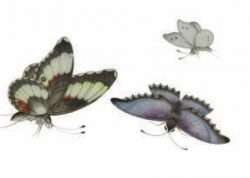 On May 9th Christie's will be offering an incredibly fine and rare pair of Qianlong double-gourd vases.
On May 9th Christie's will be offering an incredibly fine and rare pair of Qianlong double-gourd vases.
The pair was discovered during a house call by Christie's representative Jeremy Morgan. After looking through a number of rooms of the house, the homeowner suggested there might be a few more things in the drawing room. On the mantle of the drawing room were these vases. perhaps the only pair of this kind in the world. In the past, only four have these have ever appeared on the market, never a pair. Some are speculating these may be the most expensive Chinese porcelains ever sold in the United Kingdom. Which obviously means they could sell for more than many times more than their estimate.
The present owners inherited then from a family member who is thought to have bought them in 1930's. A previous estimate by another firm valued them at under $1,000 in the past.
Excerpt Description: QIANLONG DOUBLE-GOURD VASES
The catalog entry below was prepared and written by: Rosemary Scott, International Academic Director Asian Art, Christie's.
This magnificent and rare pair of vases belongs to a very small group of Qianlong famille rose
enameled double-gourd vessels decorated with exceptionally well-painted butterflies and
flowers. Only four other single vases of this type appear to have been published. One of these
was sold by Sotheby’s Hong Kong in 1998; another was sold by Christie’s Hong Kong in 1991;
a third, which had previously been sold by Sotheby’s Hong Kong in 1979, was sold by Christie’s
Hong Kong in 2000; and a fourth, which had previously been sold by Christie’s in 2003, was
sold again by Christie’s Hong Kong in 2007.
Sale of the current vases appears to represent the
first time that a pair of these rare Qianlong vases has been offered at auction. The pair was
recently discovered in an English country house. The vases were collected in the 1930s by an
English lady from a noble family, and have passed by descent to the current owner.
Addendum May 9th, 2017: The vases sold for around 6 times the high estimate at $19,068,875.00
Background
The combination of flowers and butterflies to decorate Chinese porcelain can be seen as early
as the Yongle reign (1403-24) on blue and white vessels such as the pear-shaped vase in the
Percival David Collection (illustrated by Rosemary Scott in Elegant Form and Harmonious
Decoration - Four Dynasties of Jingdezhen Porcelain, Percival David Foundation, London, 1992, p.
38, no. 25), and the Chenghua reign (1465-87) on polychrome doucai wares, such as the globular
jar also in the Percival David Collection (illustrated ibid. p. 64, no. 61). However, the combination
of butterflies and flower sprays painted in overglaze enamels on porcelain became particularly
popular at the imperial court in the Yongzheng reign, following the development of the famille
rose palette of enamel colors.
The choice of this combination of decorative motifs can be seen
on the famous ‘butterfy bowls’ of the Yongzheng reign, which bear butterflies and flowers in
the form of roundels. An example of this Yongzheng bowl type is in the collection of the Palace
Museum, Beijing (illustrated in Porcelains with Cloisonne Enamel Decoration and Famille Rose
Decoration, The Complete Collection of Treasures of the Palace Museum, 39, Hong Kong, 1999,
pp. 78-9, no. 68), and another, from the Yuen Family Collection, was sold by Christie’s Hong
Kong on 30 April 2000, lot 588.
Interestingly, although the current vase, like the Yongzheng
bowls, has a pure white ground, the butterflies and flower sprays which decorated it display
many similarities with those on the exceptional Qianlong vase with pink graviata ground from
the Ping Y. Tai Foundation, which was sold by Christie’s Hong Kong in December 2008. Indeed
a number of the same flowers and types of butterfly appear on both vases.
The current vases and the Ping Y. Tai vase relate to a small number of Qianlong porcelain vases
decorated in 琺瑯彩 falangcai enamels with designs of butterflies and flowers on colored
graviata grounds. The colors of these graviata background enamels vary. An example of deep
pink enamel with lattice graviata designs forming the background for the butterflies and flowers
can be seen on a Qianlong vase in the Victoria and Albert Museum (illustrated by Rose Kerr
in Chinese Ceramics - Porcelain of the Qing Dynasty 1644-1911, Victoria and Albert Museum,
London, 1986, p. 116, pl. 99). However, on the Victoria and Albert Museum vase the flowers grow
from the lower part of the band, rather than appearing as small sprays - as on the current and
Ping Y. Tai vases.
Three very similar Qianlong vases, one in the collection of the National Palace
Museum, Taipei, and a pair in the Baur Collection are decorated with butterflies and foral
sprays on a deep pink ground with graviata scrolls (illustrated in Emperor Ch’ ien-lung’s Grand
Cultural Enterprise, National Palace Museum, Taipei, 2002, p. 197, no. V-34; and by John Ayers in
Chinese Ceramics in The Baur Collection, volume 2, Collections Baur, Genève, 1999, pp. 128-9,
no. 236 and 237, respectively). Another Qianlong vase in the collection of the Palace Museum,
Beijing has a blue enamel ground with graviata lattice design, which forms the background for
a design of butterflies, foral sprays and flower heads (illustrated in The Complete Collection of
Treasures of the Palace Museum 39 Porcelains with Cloisonne Enamel Decoration and Famille
Rose Decoration, op. cit., p. 37, no. 30.
As is usually the case with pairs of Chinese vases, the designs on the two vessels are not
identical but are complementary. The minor bands are the same on each vase and the choice
of motifs is the same, but the disposition of the flowers and butterflies differs slightly. The
butterfies and fowers are exquisitely painted, and most of the latter can be identified with a
reasonable degree of confidence. Those painted around the main body of the vessels are shown
as flower sprays, while those around the upper bulb are painted simply as fower heads. The
efect is elegant and harmonious, and the choice of the fowers has been made not only on the
basis of their beauty, but also for their auspicious symbolism.
Amongst the flower which can be identified is crab-apple (Malus spectabulous 海棠花haitang hua).
The second character in the Chinese name棠 tang provides a rebus for 堂, literally a ‘hall’, but
often used to represent ‘family’ or ‘family home’. Flower heads of both crab-apple and peony
appear to be depicted on the upper bulbs of the current vases, suggesting the phrase 滿堂富
貴 mantang fugui ‘May the whole family achieve wealth and honour’. Tree peonies (Paeoniasufruticosa, 牡丹 mudan), which are also painted as luxuriant sprays on the main body of the
vases, are often known in Chinese as 富貴花 fugui hua, the ‘fowers of wealth and honour’. The
prominence accorded to peonies on the current vases also refects their position as the ‘King
of Flowers’, beloved of Chinese artists and poets, and traditionally associated with the imperial
family, who, as early as the Tang dynasty, grew peonies in the palace gardens. The herbaceous
peony (Paeonia lactifora 芍藥 shaoyao) is of ancient origin in China and is mentioned in the 9th
century BC Book of Odes (詩經 Shijing). It was traditionally a token of love and was exchanged
as a farewell gift. While the tree peony is the ‘King’ of fowers, the herbaceous peony is regarded
as the ‘Prime Minister’.
Painted with equal prominence on the current vases is another pink flower, which could be
mistaken for a peony, were it not for the shape of its leaves. This is hibiscus, specifically Hibiscus
mutabilis, which in China is known as 木 芙 蓉 mufurong or sometimes 拒霜花 jushuanghua
(literally ‘resisting frost flower’). This particular species, which is the most celebrated in China,
is famous for the fact that it is white when it opens in the morning, but gradually becomes pink
as it fades towards the evening. This feature gives rise to another name in Chinese 醉 酒芙 蓉
Zuijiufurong – drunken hibiscus. The combination of hibiscus and rose is auspicious, suggesting
the phrase 長春 榮華 changchun ronghua – May you have wealth and glory in addition to long
life. Roses are also painted in the vases to provide this wish, as well as being highly decorative.
These are the Chinese Rose, Rosa chinensis 月季 yueji (monthly rose or four seasons rose). The
name monthly rose derives from the plant’s long blooming season – it blooms almost every
month. This quality leads to its other name 長春花 changchunhua, eternal spring fower. Since
the roses on these vases also appear with peonies, they provide the suggestion of another
auspicious phrase 長春 富貴 changchun fugui – May you enjoy eternal spring (longevity), wealth,
and honour.
Chrysanthemums (Chrysanthemum morifolium, 菊花 juhua) are also prominent on the current
vases. Along with lotus, orchid, and bamboo, the chrysanthemum is regarded in China as one of
the ‘four gentlemen of flowers’. Like peonies, chrysanthemums are also mentioned in such early
classical literature as the Book of Odes, and are symbols of longevity and wealth as well as being
the flowers representing autumn. The reason they are associated with longevity is because
the word for chrysanthemum 菊 ju sounds similar to the word 久 jiu, meaning ‘long-enduring’,
and also because infusions made from chrysanthemum petals have medicinal properties,
while other parts of the plant are also edible.
With its profusion of similarly slender petals, the
blue China aster (Callistephus chinensis) painted on the vases is known in China as cuiju 翠菊
or kingfisher chrysanthemum. Some scholars have identified China aster amongst the plants
mentioned in the Book of Odes, and certainly, it is a fower that has been a favorite amongst
artists since at least the Song dynasty. With the advent of a vivid blue overglaze enamel in the
early part of the 18th century, China asters became a popular motif on imperial porcelain.
Perhaps the most vibrant flowers depicted on the current vases are camellias. While more
than two hundred species of camellia are native to China, it is invariably Camellia japonica 山
茶 shancha, which is depicted in Chinese art. As seen here, the blossoms of this plant have
fve deep red petals with a projecting dense cluster of yellow stamens in the centre. Their red
colour is associated with joy and protection and is thus regarded as auspicious. As this species
blooms around the time of Chinese New Year, its blossoms are among the flowers used to
decorate homes, in order to secure prosperity in the coming year, as expressed by the phrase 花
開富貴 huakai fugui. Jasmine is one of the flowers most highly prized for its fragrance in China, and Arabian jasmine
(Jasminum sambac 茉莉花 moli) with its dainty white blossoms is, not surprisingly, another
flower painted on the current vases. Such fragrant jasmine fowers were used in the 18th
century to decorate and to perfume the emperor’s apartments. It was, and still is, highly valued
for scenting tea, as well as syrups and sweetmeats. Jasmine was used to perfume clothes,
and ladies were known to wear its flowers in their hair. Another fower prized for its exquisite
fragrance and worn by ladies in their hair, and used to perfume their cosmetics and incense, may
also be depicted on the vases. This is gardenia (gardenia augusta 梔子花 zhizihua), which some
scholars have suggested was so valuable in the Han dynasty that the income from 66 hectares
of gardenias would have been the equivalent of the taxes from 1000 peasant households.
Gardenias roots, as well as their leaves and fruit, were used in Chinese medicine, while the fruits
were also traditionally used to produce a yellow dye. Gardenia floribunda was also amongst the
auspicious plants included in the special still-life paintings executed for the annual Duanwu
Festival (端午畫題 Duanwu huati), held on the ffth day of the ffth month of the lunar calendar.
The only vine included amongst the flowers on the vases is convolvulus or morning glory with
its striking blue trumpet-like fowers. Ipomoea convolvulacae has been known in China for
generations, and appears in paintings such as the Song Hundred Flowers in the Palace Museum,
Beijing. It is found on certain early 15th century blue and white vases made at the imperial
kilns, but is relatively rare as decoration on Chinese porcelains. One of its names in Chinese
is 牽牛花 qianniuhua – literally lead ox fower. This derives from the story of a farmer, who was
cured of an illness by eating the seeds of this fower and who subsequently led his oxen into
the felds in order to give thanks to the plant which had saved his life. Morning glory is also a
symbol of marital bliss. All these fowers, with their auspicious references, and other such as
pinks (Dianthus chinensis 石竹 shizhu), gerbera (Gerbera jamesonii - 扶郎花 fulang hua and 千日
菊 qianriju are among gerbera’s Chinese names), etc., are harmoniously disposed over the main
body of the vases and visually complemented by the variety of butterflies fluttering above and
between them.
Around the bases of the vases are vibrant bands of overlapping pink-tipped lotus petals. Similar,
richly painted, bands of overlapping lotus petals can be seen on imperial porcelains of the
Yongzheng reign – as in the case of those around the foot of an imperial famille rose circular box
with pierced lid in the collection of the Palace Museum, Beijing, (illustrated in Porcelains with
Cloisonne Enamel Decoration and Famille Rose Decoration, The Complete Collection of Treasures
of the Palace Museum, op. cit., pp. 90-91, no. 79). Similar bold lotus bands, highlighted by fne
deep pink outlines and veining on the petals, can also be seen on a small number of especially
fne Qianlong porcelains, such as the current pair of vases. The lotus is a popular theme for the
Chinese decorator, since it has attractively shaped leaves as well as beautiful flowers. Lotus
(Nelumbo nucifera) are associated with Buddhism and are also symbols both of feminine beauty
and of purity - the latter because the blossoms rise unsullied from the mud. One word for lotus
(荷 he) is a homophone for the word for harmony (和). Another word for lotus 蓮 lian sounds like
the word for ‘successive’ (連), and so the motif of a boy holding a lotus – either the fower or the
leaf - is a pun for continually giving birth to boy babies. However, an extension of this term for
lotus is 青蓮 qinglian, which provides a rebus for 清廉 qinglian, meaning incorruptible.
In the style of their painting, it may be that the flowers on imperial Qing porcelains of this type
were influenced by the work of artists such as 惲壽平Yun Shouping (1633-1690), an early Qing
artist who is regarded as one of the ‘Six Masters’ of the Qing dynasty. Inspired by the masters
of antiquity, Yun Shouping became known for his elegant fower paintings, which combined
his ability to capture the essence of each fower with a willingness to use the natural, vibrant,
colours sometimes eschewed by other artists. Yun Shouping’s scroll painting of A Hundred
Flowers After Xu Chongsi [徐崇嗣, Northern Song dynasty], dated by inscription to AD 1666,
which was sold by Christie’s Hong Kong in April 1997, demonstrates this particularly well, and
includes the majority of the fowers painted on the current vases.
A wide variety of different butterflies are painted on these vases - executed with exceptional
delicacy, which emphasizes the fragile, shimmering, beauty of their wings. Butterflies are
often included in Qing dynasty decoration in order to suggest duplication of an auspicious
wish, since the word for butterfly in Chinese 蝶 die is homophonous with a word 疊- meaning
to repeat. It also sounds like 耋 - a word meaning over seventy or eighty years of age, and thus
expresses a wish for longevity. When combined with plum blossom, butterflies provides a rebus
for beauty and longevity. Butterflies are also seen as symbols of happiness in marriage, as well
as everlasting romantic love. The latter interpretation is due to a number of traditional Chinese
stories in which butterflies play a significant part. The most famous of these is by the Ming
dynasty writer 馮夢龍 Feng Menglong (1574-1646), in which the so-called ‘butterfy lovers’ 梁山伯
Liang Shanbo and 祝英台Zhu Yingtai are transformed after death into butterfies. Additionally,
in Daoism butterfies are associated with dreamlike reflection and the freedom of the soul.
These extremely rare vases are thus not only vessels of great beauty, but also bear a wealth
of auspicious messages, which would have rendered them suitable for presentation on the
occasion of an important birthday or similarly significant celebration.
In Chinese
琳瑯重華
此對瑰麗高雅的粉彩花蝶紋如意耳葫蘆尊, 蒜頭口, 腹碩圓,口,肩連以如意形耳,圈足.外通體白釉地上繪以形態各
異的彩蝶及各式花卉, 爭奇鬥艷, 相映成輝。已出版的此類葫蘆形瓷器 僅有四件,其中兩件分別於1998年由香
港蘇富比,及1991年於香港佳士得拍賣。另一件曾於1979年由香港蘇富比拍賣,並於2003年由香港佳士得再次
拍賣。還有一件則於2003及2007年於香港佳士得拍賣。此次拍賣中將如此珍罕乾隆粉彩葫蘆瓶成對呈現, 實為
史無前例. 其出處亦顯赫有序, 由一位英國貴族於1930年代購入,由其家族珍藏至今.
花蝶同綴的裝飾風格最早見於永樂青花及成化鬥彩。大維德爵士收藏中的青花荸薺瓶及罐均有此類紋飾,詳見
蘇玫瑰所撰的《形秀色麗四代珍》,倫敦,1992年,38頁,編號25及大維德爵士收藏ibid 64頁,編號61。然而,以
釉上彩描繪花卉舞蝶紋則盛行於雍正朝發明粉彩之後。最負盛名的一例為雍正蝴蝶紋大碗, 北京故宮博物院
珍藏一件,圖見《故宮博物院藏文物珍品全集,琺瑯彩,粉彩》,第39冊,香港,1999年,78-9頁,編號68,另一
件為Yuan Family Collection舊藏,香港佳士得於2000年4月30日拍賣。雖然此拍品與雍正碗同為白地,但其花蝶
紋飾卻和2008年12月於香港佳士得拍賣,戴萍英基金會舊藏之乾隆御製粉紅地粉彩軋道蝴蝶瓶如出一轍。
此拍品及戴萍英之舊藏原屬同一組乾隆款軋道錦地琺瑯彩瓷,組內器物上之花蝶顏色繽紛,形態各異。維多
利亞與艾伯特博物館藏中有一件胭脂紅地卷草紋琺瑯彩瓷瓶。圖見於柯玫瑰所著之《Chinese Ceramics –
Porcelain of the Qing Dynasty 1644-1911》,維多利亞與艾伯特博物館,倫敦,1986年,116頁,編號99。但該館藏
品的花卉圖紋由下至上,而戴萍英舊藏及此拍品之花蝶紋飾則均佈瓶身。台北國立故宮博物院亦藏一件相似的
乾隆大瓶,另,鮑氏東方藝術館藏一對,均以胭脂粉紅軋道為地,配以花蝶紋飾。再, 北京故宮博物院藏一件乾
隆琺瑯彩藍紫地花蝶瓶, 通體外施藍紫釉,外壁軋道地上彩繪各式西洋花卉, 其重點綴幾隻彩蝶。圖見《故宮博
物院藏文物珍品全集,琺瑯彩,粉彩》37頁,編號30。
成雙成對的瓷器通常在裝飾上相輔而不相同,此拍品亦不例外。儘管瓶身上的紋飾, 彩蝶和花卉均精巧細膩,佈
局卻稍有不同。其中花卉描繪更是細緻入微,栩栩如生,足以令觀者辨識出各色品種。瓶腹以嬌媚的花枝為主,
頸部則以花朵綴之,整體秀雅悅目,其中花卉圖案不但精美典雅,更各具吉祥寓意。
瓶身可見海棠與牡丹。「棠」通「堂」,代表家宅,牡丹則為富貴花。海棠牡丹盛開象徵滿堂富貴。富麗堂皇的牡
丹又為百花之首,不僅為歷代文人喜愛,更是帝王象徵。早於唐代,皇室已於上苑栽種牡丹。牡丹為芍藥屬花,
源於中國,公元前九世紀的《詩經》已有紀載。芍藥為定情之物,臨別相贈可寄託惜別之情。與牡丹形似之粉紅
色木芙蓉,其葉形異於牡丹,又名拒霜花。醉芙蓉清晨開白花,傍晚漸轉粉紅,惹人喜愛。又, 有月季,別名長春
花。因每月盛開故而得名。月季與芙蓉有長春榮華之意,月季伴牡丹則寓意長壽、富貴榮華。另, 可見梅、蘭、菊、
竹「四君子」中之一的菊花,《詩經》中亦有記載。菊花代表秋天,「菊」與「久」音近,有長壽之意。其花瓣可入
藥,其他部份亦能入食。纖細的菊花瓣與翠菊相似 , 據《詩經》載,翠菊自宋代起已深受文人畫家偏愛。繼十八
世紀藍色料彩被發明後,翠菊就常見於御製瓷器中。其中最奪目的當屬山茶花。產自中國的山茶科植物幾百種之
多,各式瓷器及工藝精品上卻唯見山茶花。此花以五紅瓣簇擁點點黃蕊,甚為可愛。山茶花只於農曆新年期間
開放,是時百姓皆以此點綴家宅,祈求來年花開富貴。因茉莉的香氣沁人心脾,十八世紀時便常以其為香薰御
寢。時至今日茉莉仍被用於茶葉製作及薰香衣物,女士們亦會別在耳後。梔子花清秀雋永, 據考漢朝時六十六公
頃的梔子花相當於一千戶農民的稅款,足見其珍罕。梔子花的根、葉和果均可入藥,果實亦可製成黃色染料。農
曆五月五日端午畫題用的清供圖多見象徵祥瑞的花草,梔子花即為其一。牽牛屬花自古以來已為人認識,北京故
宮博物院藏宋畫上亦見其芳蹤。雖然數件十五世紀御製的青花瓷可見牽牛花紋飾,但它實為舶來品。相傳一隱
士食用牽牛花籽後大病痊癒,遂偕牛下田答謝,牽牛花因而得名。拍品中亦見石竹、扶朗花(又名千日菊)等紋
飾。各種寓意吉祥的花卉競相盛開,彩蝶於其中穿插飛舞, 畫面靜中寓動, 高雅秀麗.
此拍品近足處的蓮瓣紋呈粉紅色。雍正朝御製的粉彩鏤空團壽蓋盒上亦有類似色彩豐潤的蓮瓣紋,圖見《故宮
博物院藏文物珍品全集,琺瑯彩,粉彩》,90-91頁,編號79。少量傳世的乾隆瓷器上亦可見胭脂紅勾勒的蓮紋
彩箍,此拍品即為一例。中國工匠喜用蓮花紋飾,取其標緻葉形及脫俗花朵。蓮與佛教密不可分,其出汙泥而不
染之特質更象徵女性的柔美純潔。「蓮」又作「荷」,通「和」,寓意和諧。「蓮」又通「連」,男童手執蓮花意喻
連生貴子。蓮花亦可引申至青蓮,寓意清廉。
清代御製瓷器的畫風可能受「清六家」之一的惲壽平的影響, 他以古代歷位大家為宗,亦敢於以濃豔逼真的顏
料作畫,其筆下的花卉形神俱備, 栩栩如生, 香港佳士得1997年上拍的畫卷《百花圖》中便可見一斑,並收納了此
拍品上的大部分花卉。
此拍品上的彩蝶畫工細膩,突顯蝶翼的輕薄和光澤,粉潤有致。「蝶」通「疊」,清代瓷器常以蝴蝶暗喻祥瑞成
雙而來。「蝶」又通「耋」,寓意壽比南山。蝴蝶梅花並用隱喻美麗長壽。蝴蝶又為琴瑟和樂,愛情永固的象徵。
許多中國民間傳說都有蝴蝶的蹤影,明代馮夢龍筆下的梁山伯和祝英台便在殉情後雙雙化蝶,象徵不渝愛戀。
道家思想中,蝴蝶則與夢幻、自由意志相連。
此對拍品瑰麗別緻,其豐富的吉祥含意更是不言而寓,極可能是祝壽或其他重大慶典時用的賀禮,實為可遇不可
求的珍惜矜貴之物.
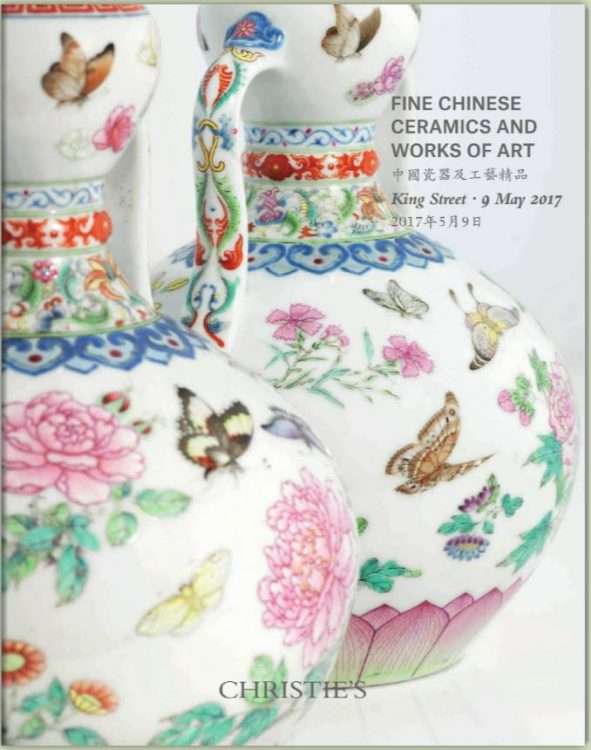
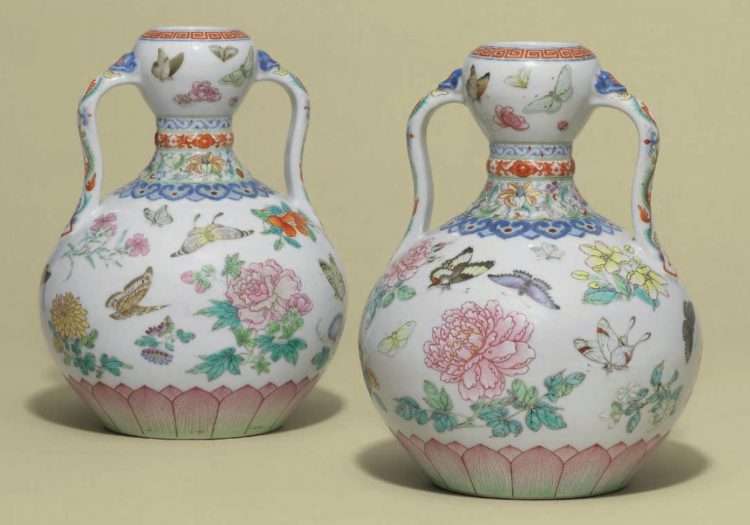
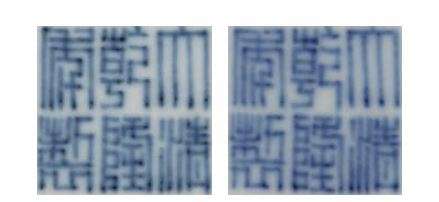
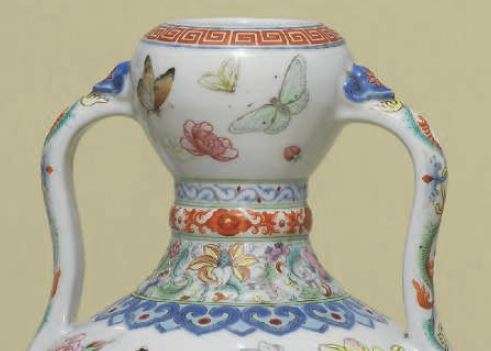


Leave a Reply